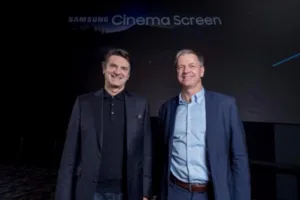On November 20, two special guests visited Samsung’s Cinema LED screen at the Super-S Theater in Lotte World Tower, Seoul. On a short visit to Korea, Franz Kraus and Dr. Joerg Pohlman came from Germany to acquaint themselves with Samsung’s new cinema screen technology first-hand.
Executive Board of Arnold & Richter Cine Technik (ARRI Group) – a leading designer and manufacturer of camera systems and lights for the motion picture media industry. Founded in 1917 in Germany, ARRI now has subsidiaries across the globe, and every year several hundred feature films are shot with ARRI cameras.
Samsung Newsroom sat down with Kraus and Pohlman to discuss their initial reactions to the screen.
ARRI’s Executive Board, Franz Kraus and Dr. Joerg Pohlman, in front of the Samsung LED Screen
“I have waited for four months to see the Cinema LED screen”
The Cinema LED screen is the world’s first LED screen designed to replace conventional projectors in cinemas. The new screen, which has overcome limits in brightness and a light-to-shade ratio, supports 4K resolution and high dynamic range (HDR), thus producing clear and vivid color. In addition, directly beamed LED light sources prevent color distortions, giving fuller realization to what directors originally intended to express. The innovative screen installed with JBL sound systems of Harmon Kardon provides viewers with a whole new level of audio experience.
Film technology is constantly developing in the digital era. However, film screening is still based on projection, which has served as an obstacle in realizing true and lifelike high-quality resolution. Against this backdrop, the arrival of a Cinema LED screen was a breath of fresh air for the ARRI Executive Board.
ARRI’s Executive Board member, Franz Kraus, recalled the moment when he first heard the news about the Cinema LED screen, saying, “I read the news and I thought: I must go to see it.” At last, four months later, he arrived in Seoul to witness the effects of Cinema LED for himself.
Before the lights were turned off and the Cinema LED screen was turned on, Kraus expressed high expectations for the LED screen, saying, “I expect to see images superior to the best projection system available today in respect to contrast, color rendition, peak brightness, and reproduction of fine detail. I am curious about the local audio resolution as the LED screen doesn’t allow for the usual setup of three or five speakers behind the screen.”
Reviews of the Satisfaction with New Cinema Technology

The pair watched an ARRI show reel which had been remastered for the Cinema LED Screen. Pohlman, Executive Board member at ARRI, admired Samsung’s technology, saying: “Samsung is a pioneer with this technology. For us, it’s always about bringing technology one step further.”
“When you look at movie theaters, I think one of the challenges for them will be to keep up with the development of TV screens. With the advent of HDR, there’s a lot more that can be seen and, in the future, our visual impressions are going to be different from now. It’s about taking time to make sure that theaters in the future will be of a very high quality, so that people will want to watch movies in them.”
“I think LED is showing the right way and certainly you can see a lot more on an LED screen. There’s a lot of detail, it’s very rich in color. Of course, with the blacks there’s the contrast, so it’s a very interesting technology. It’s great that Samsung is moving technology forward.”
The Cinema LED screen boasts an advantage that viewers experience no distortion in images and sound, wherever in the theater they choose to sit. After confirming this for himself by moving from seat to seat in the theater, Kraus expressed full satisfaction with the technology.
Leading Desirable Change in the Film Industry
Since the people of ARRI are creators themselves, this new way to display has certainly piqued the Executive Board’s interest. The two also gave their opinion about the future impact of the Cinema LED screen on the film industry, and on cameras and lighting specifically.
“One of the very simple things that we were looking for was if you would be able to see the seams or any fixed pattern structure from the individual panels,” Joerg Pohlman remarked. “And you really could not see them. I thought it was extremely impressive. The interesting question is whether and how the creatives in our industry will manage to create images that utilize the full capabilities of the LED screen, delivering life-like images in the cinema.”
Franz Kraus added: “Of the images from the ARRI demo reel we watched, some of them worked very well. What I really liked was that the images looked very good, both in SDR as well as in HDR (with ten times the peak brightness). The amount of detail in the darker parts of the image was just marvelous. Even when I strained my eyes, I could not see any trace of technical evidence and the images looked very cinematic.”
Throughout their history, conventional projection systems have been faced with limitations in fully expressing clear and lifelike images. These limits have now been overcome with the emergence of the Cinema LED screen. The Cinema LED screen has become a “must see” for film makers and moviegoers who are seeking a whole new experience in image and sound.


